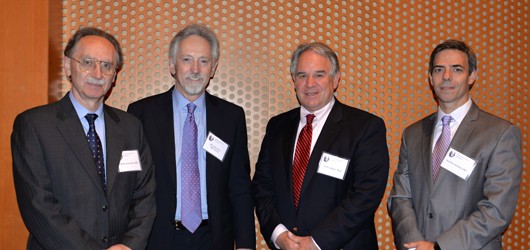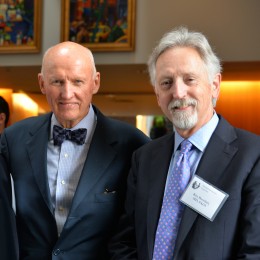
Kim Burchiel, MD, the John Raaf Professor and Chairman of the Department of Neurological Surgery at Oregon Health & Science University, is challenging the long-held belief that trigeminal neuralgia is caused by a pulsing blood vessel that beats against the trigeminal nerve, causing demyelination and triggering shock-like pain in the face.
Speaking recently as the Mayfield Lecturer at the 32nd Mayfield Neuroscience Symposium, Dr. Burchiel raised the possibility that the onset of trigeminal neuralgia is genetic, arising from an individual’s DNA.
The Mayfield Symposium coincided with graduation ceremonies for three neurosurgery residents from the University of Cincinnati College of Medicine: Ben Bixenmann, MD, Cyrus King, MD, and Mark Magner, MD. The event also featured Alumnus Lecturer Norberto Andaluz, MD, a Mayfield neurosurgeon and skull base expert, and a special lecture by Jeffrey Keller, PhD, who is retiring as Research Professor and Director of Education in the UC Department of Neurosurgery.
Dr. Burchiel piqued the interest of his audience of faculty and neurosurgery residents with his novel – and perhaps controversial — questions about trigeminal neuralgia, which affects one in every 25,000 people. “Some of our concepts of what causes trigeminal neuralgia are outdated,” Dr. Burchiel said.
Listen/watch the 2015 Mayfield Lecture »
Dr. Burchiel agreed that the most common treatment for trigeminal neuralgia, microvascular decompression (MVD), is effective for most patients. During the procedure, surgeons move the compressing artery aside and place a sponge between the nerve and artery. “It’s a rewarding procedure for neurosurgeons, as the vast majority of patients wake up pain free and are very grateful,” he said.

But the condition is less straightforward than it might seem, Dr. Burchiel continued. Some patients who are effectively treated with MVD will have a recurrence 5 to 10 years later. In addition, about one-third of patients with classic trigeminal neuralgia symptoms are found to have no artery compression at all. “When we operate on them, the anatomy is normal and no vessels are seen touching the nerve,” he said.
In these latter cases, the surgeon can achieve pain relief by causing slight trauma to the nerve root, thereby deadening the pain signals. This resolves the patient’s pain, but it leaves a conundrum: “How do we then accept that artery compression is the cause of trigeminal neuralgia,” Dr. Burchiel asked.
In fact, he argued, it is “a myth” that trigeminal neuralgia is caused by vascular compression; that recurrent trigeminal neuralgia after MVD is caused by new compression or a tortuous artery; that trigeminal neuralgia occurs on one side of the face, not both sides; and that MVD is a cure.
“Something else is going on here,” Dr. Burchiel said. “When we look at the normal population, about 17 percent of people have vascular compression, yet only .01 percent experience trigeminal neuralgia. So clearly vascular compression is not a cause of trigeminal neuralgia.”
Further evidence that compression is not the cause, Dr. Burchiel said, rests with age of onset. Onset for people without artery compression peaks at 40; onset for people with compression peaks at 50. Peak onset in middle age, he said, strongly suggests progression of disease.
Driving the discussion toward genetics, Dr. Burchiel is leading an international DNA study of patients with trigeminal neuralgia, looking for clues to a possible genetic cause. “We will enroll 1,000 patients, which will make this is the largest genetic study of pain ever conducted,” he said. “We’re going to figure out what genes are associated with this. We have 10 to 15 candidates already. It probably won’t be one gene, but a constellation of genes. The picture is starting to become clearer.”
Dr. Burchiel’s ambitions for the study extend beyond developing a better understanding of trigeminal neuralgia. He envisions the development of new drugs and new treatments. “It also might inform us of the origins of neuropathic pain in general,” he said. “That is even more exciting, because right now we don’t have drugs for neuropathic pain. But if we knew the gene, or genes, we could treat it specifically.”
— Tonya Hines & Cindy Starr